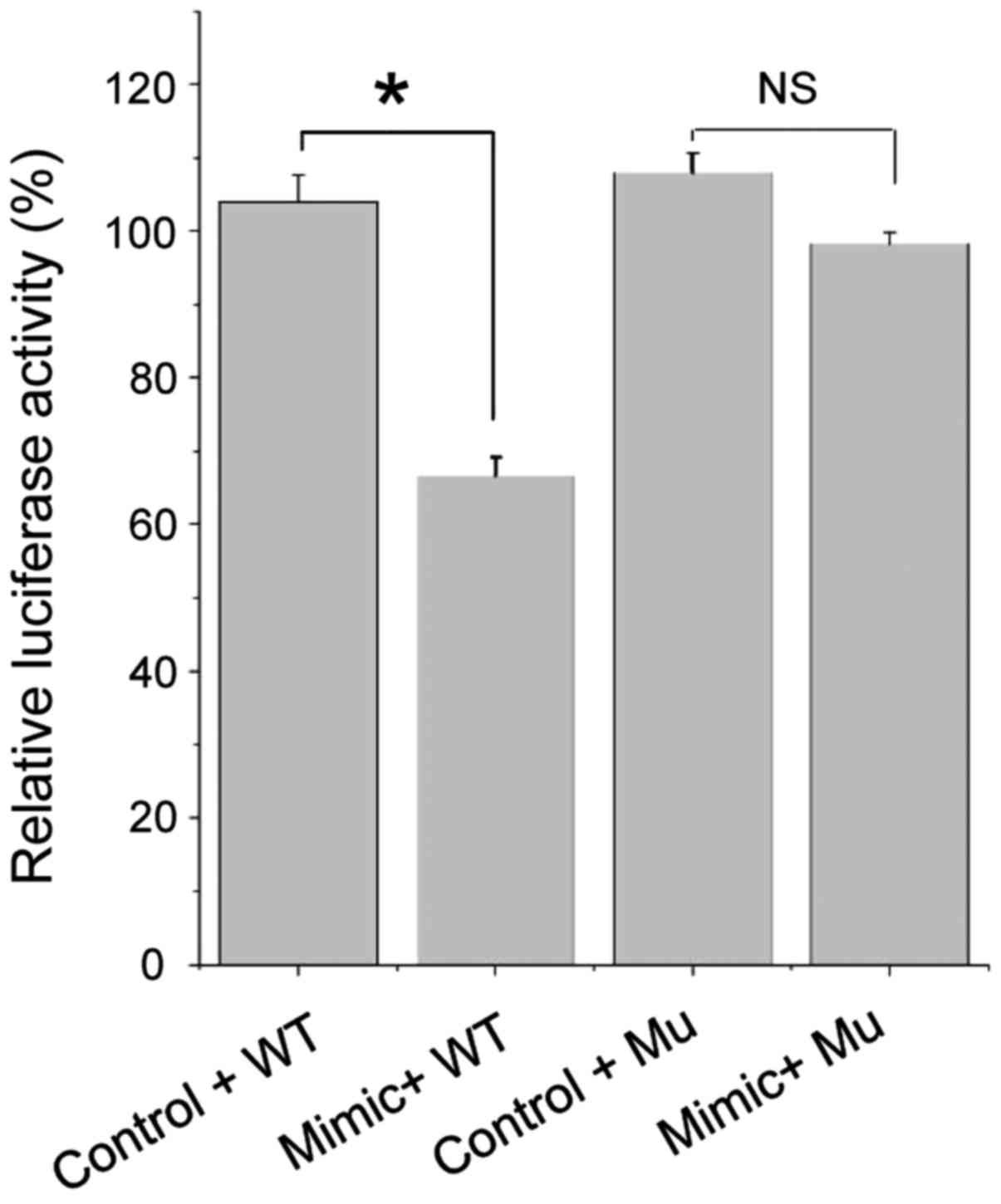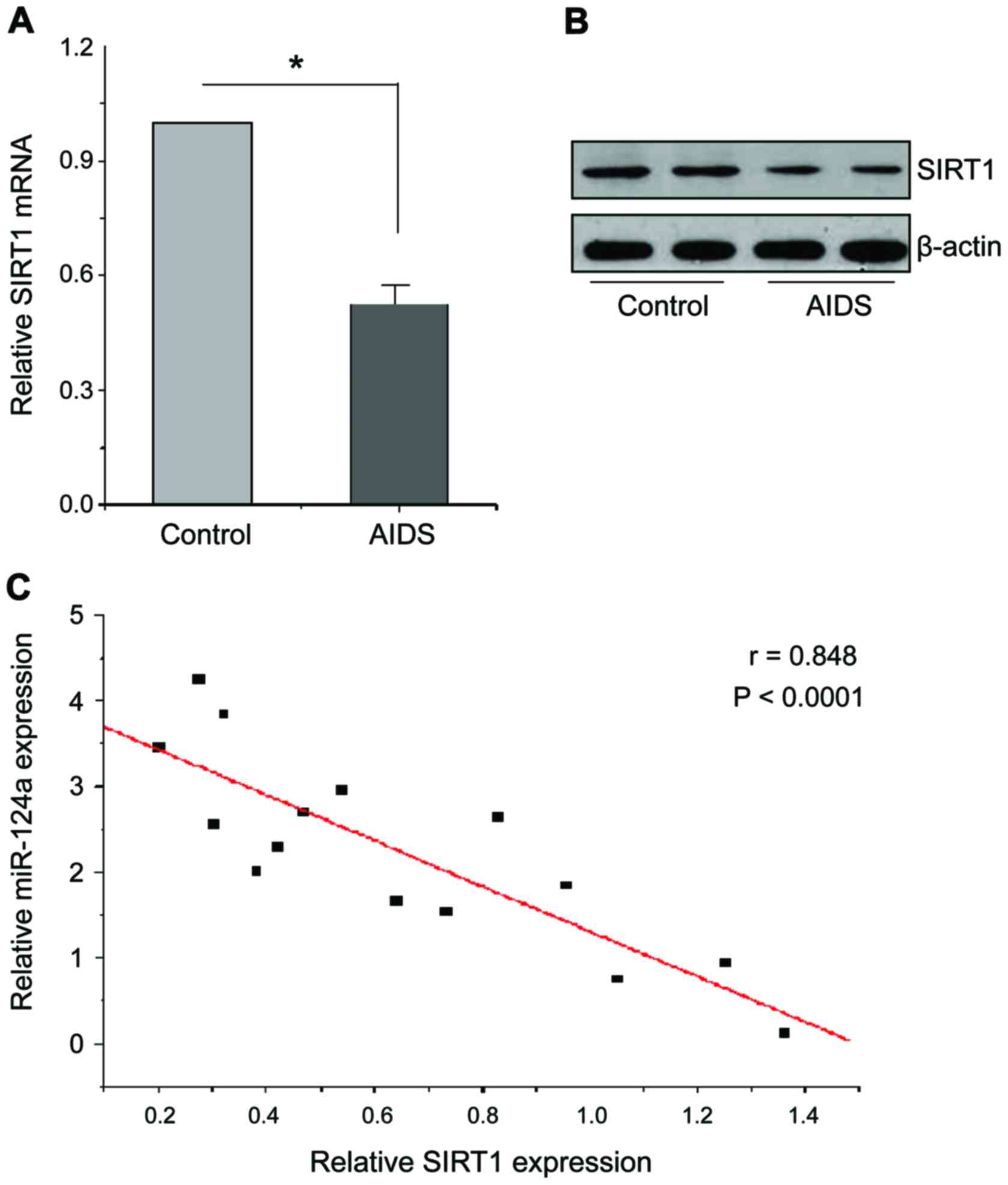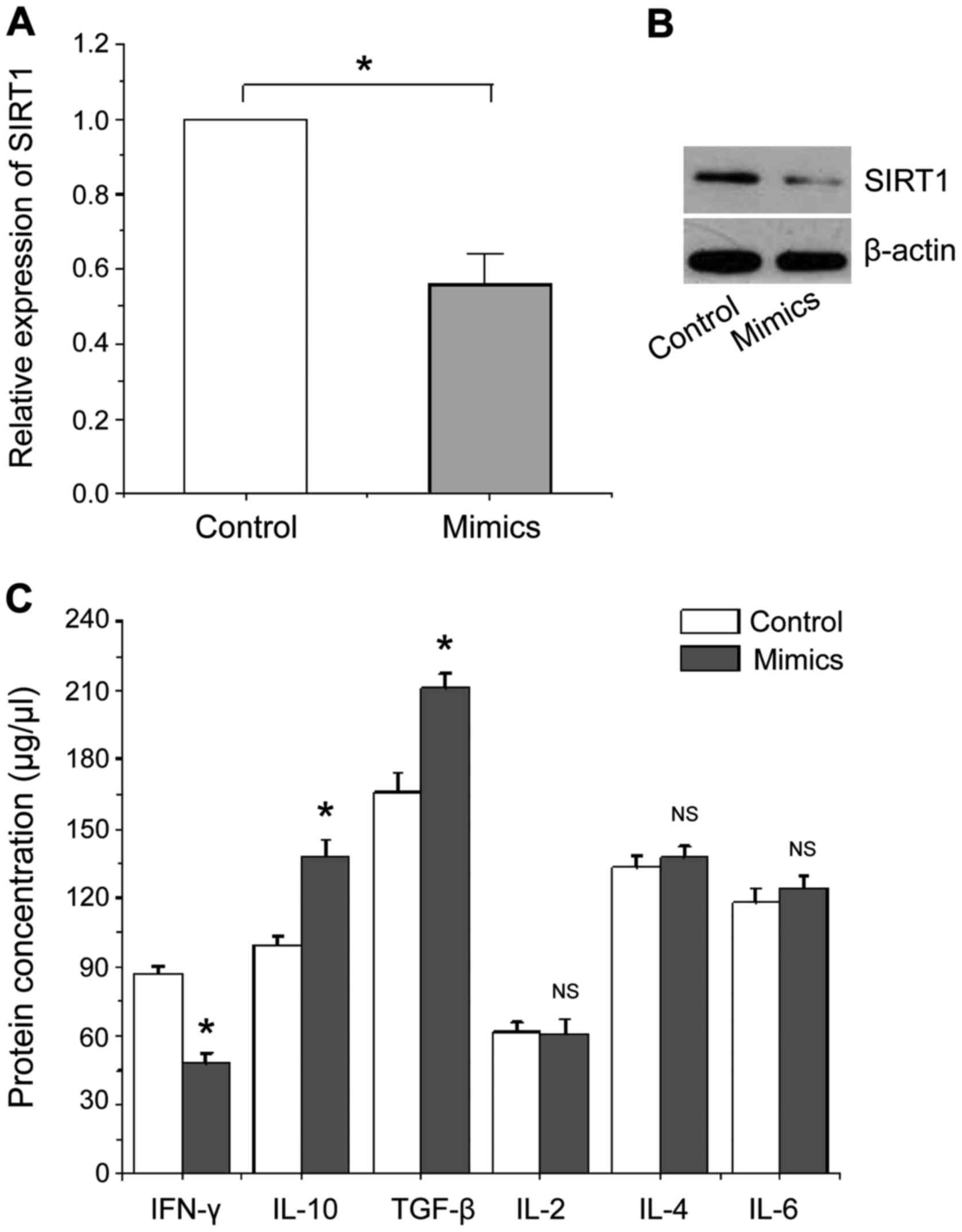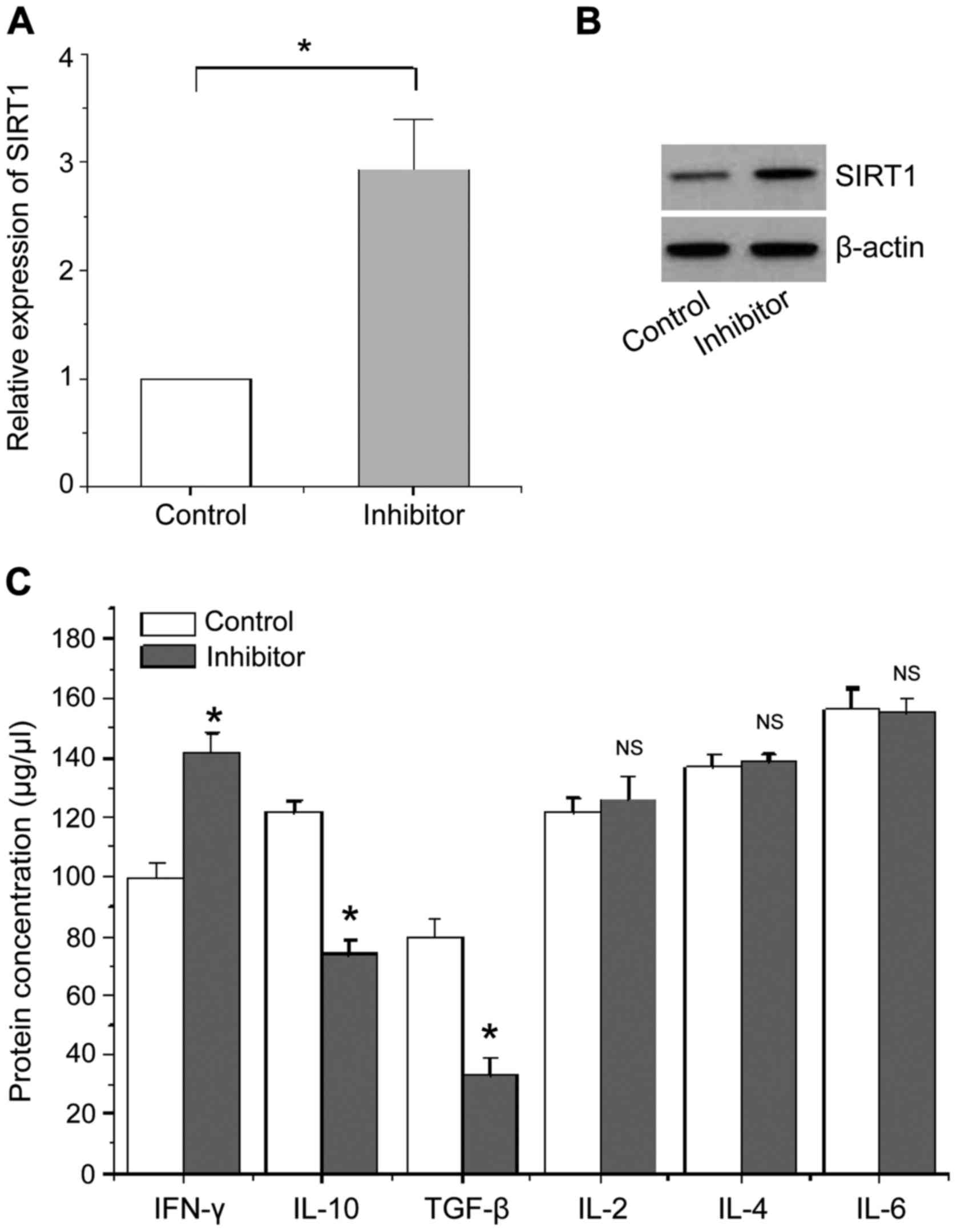Role of miR-124a in T cell activation and immunity in AIDS patients
- Authors:
- Published online on: September 15, 2017 https://doi.org/10.3892/etm.2017.5119
- Pages: 4807-4812
-
Copyright: © Zhao et al. This is an open access article distributed under the terms of Creative Commons Attribution License.
Abstract
Introduction
Acquired immune deficiency syndrome (AIDS), is caused by the human immunodeficiency virus type 1 (HIV-1) infection. The virus damages the cell mediated immune system in the infected individuals. The Joint United Nations Programme on HIV/AIDS (UNAIDS) reported that mortality due to AIDS is more than 40 million patients to date, and prevalence of the infection is 35 million worldwide (1). Although drugs have been developed to control the replication of the virus and the deterioration of the disease, but so far, no treatment strategy that can completely cure AIDS due to the high endurance and mutation rate of HIV-1 virus, other factors are changed cellular immune function after infection, and inhibited apoptosis of infected cells (2,3). The main target of HIV-1 is the CD4+ T cells of the human immune system, that is, helper T cells (Th). These cells play a significant role in assisting humoral immunity and cellular immunity (4).
On invasion of the body by antigen T lymphocytes after perceiving the signal activate and proliferate into effector T cells, which can play roles in immune response by releasing lymphatic factors. T cell activation is a very complex process that requires two kinds of signals from the extracellular stimulus. The first signal is a specific binding of the T cell surface receptor (TCR) to the MHC-antigen peptide complex on the surface of the antigen presenting cell (APC), and the second signal is derived from the interactions between co-stimulatory molecules in APC and corresponding receptor molecules on the surface of T cells, the two signals are both essential. CD4+ T cells and CD8+ T cells (cytotoxic T cells, Tc) can combine with MHC-II and MHC class I molecules, respectively (5). CD4+ T cells can be activated into effector T cells and memory T cells, and the former can secrete cytokine to regulate or assist the immune response (6).
MicroRNA is a non-coding RNA with a length of ~22 nt. In recent years, microRNA has been reported to have a role in immune response elicited by pathogenic infection (7). MicroRNA binds to the 3′-untranslated region (3′-UTR) of the target genes by base pairing to silence the expression of target gene at the post-transcriptional level. MicroRNAs also play an important role in regulating metabolism, cell differentiation, necrosis and cancer formation (8). With the development of high-throughput sequencing and computational biology, up to hundreds of microRNA families have been identified and reported, among which the miR-124 family has been shown to be able to inhibit tumorigenesis, and one of the members of miR-124 family-miR-124a can promote the differentiation of specific tissues and inhibit the expression of target gene SIRT1 (histone deacetylase), thus indirectly control the transcription factor Foxp3, so as to regulate the development and functionalization of regulatory T cells (Tregs) (9,10).
The aim of this study was to investigate the role of miR-124a in the regulation of T cell activation and immunity in patients with AIDS, and to provide new insights and therapeutic targets for the diagnosis, alleviation and treatment of AIDS.
Patients and methods
Patients
The study was conducted on 15 confirmed AIDS patients (12 males and 3 females), peripheral blood samples of 15 patients with confirmed AIDS were collected. Those patients include 12 males and 3 females with an average age of of 25±4.74 years. Out of the total, 11 cases were in pre-AIDS stage and 4 cases were in symptomatic HIV infection stage. In addition, peripheral blood samples were also collected from 15 healthy people, including 12 males and 3 females with an average age of 27±5.23 years. All the patients signed the informed consent. The Ethics Committee of Qingdao No. 6 People's Hospital approved this study. Confidentiality agreement was also signed. Informed consents were signed by the patients and/or guardians.
Methods
Materials and suppliersPRIR-REPORT luciferase reporter vector, miR-124a mimic/control and miR-124a inhibitor/control (Ambion, New York, NY, USA); lymphocyte isolation liquid (Solarbio, New York, NY, USA); Human T Cell Nuclear Transfection kit (Lonza, Bern, Switzerland); MACSRCD4 MicroBeads (Miltenyi Biotec, Bergisch Gladbach, Germany); QuickChange Lighting Mutagenesis kit (Stratagene, La Jolla, CA, USA); TRIzol reagent, PrimeScript® RT reagent kit with gDNA Eraser and SYBR® Premix Ex Taq™ II (Takara Biotechnology Co., Ltd., Dalian, China); protease inhibitors and PVDF membranes (Roche Diagnostics, Basel, Switzerland); Dual-Luciferase® Reporter (DLR™) Assay kit (Promega, Madison, WI, USA); ELISA kit (R&D Systems, Minneapolis, MN, USA); SIRT1, β-actin mouse monoclonal antibody, goat anti-mouse HRP antibody (Cell Signaling Technology, Inc., Boston, MA, USA); modified BCA assay kit (Sangon, Shanghai, China). All the primers were synthesized by Sangon.
Separation of peripheral blood monocytes (PBMs) and CD4+ T cells of by magnetic microBeadsThe peripheral blood samples (PBS) (30 ml, heparin was added for anticoagulation) of both groups were mixed with the same volume of PBS. After adding the lymphocyte isolation liquid, capillary was used to collect the monocyte layer cells. To the cell layer 7 times volume of PBS was added, the mixture was centrifuged at low-speed for 15 min, the supernatant was discarded and 1 ml PBS was added after washing the cells to resuspend the cells. According to the instruction of MACSRCD4 MicroBeads CD4+ T Cell Isolation kit, CD4+ T cells were isolated from the monocytes. The purity of the CD4+ T cells was detected by flow cytometry, after that, the cells were frozen and stored at −80°C.
RNA extraction, reverse transcription, and RT-qPCRThe total RNA in CD4+ T cells was extracted and checked according to the instructions of the kit. After reverse transcription, the cDNA was used to prepare the reaction system of qRT-qPCR. The PCR reaction was performed using the CFX-96 Real-Time PCR Detection system (Bio-Rad Laboratories, Inc., Hercules, CA, USA). The data were processed using 2−ΔΔCt method. The healthy people were used as a control and β-actin was used as the endogenous control for the PCR reaction. The primer sequences are shown in Table I.
Construction and transfection of dual-luciferase reporter plasmidsThe 3′-UTR of SIRT1 was amplified by primer SIRT1-3′UTR-F/R using the human CD4+ T cell genome as a template. This region contained a potential miR-124a binding site. After gel running, the amplified product was recovered. The pMIR-REPORT luciferase reporter vector was digested with HindIII and SpeI and the target fragment was also recovered after gel running. Those two fragments were ligated together according to the instruction of the kit. After the construction of plasmid pMIR-REPORT-WT, the recombinant plasmid was transfected and the recombinant plasmid was isolated from the transfected cells to verify the transfection. In order to verify that SIRT1 is the target gene of miR-124a, it is necessary to construct SIRT1-3′-UTR mutant reporter plasmid pMIR-REPORT-MU. To do this, the SIRT1-3′-UTR of the recombinant plasmid was mutated by QuikChange Lightning Mutagenesis kit. The primers used for plasmid construction are shown in Table I.
The combination of miR-124a mimic or its control with pMIR-REPORT-WT, and the combination of miR-124a mimic or its control with pMIR-REPORT-MU were co-transfected into Jurkat cells with the intraperitoneal luciferase endogenous control plasmid pRenilla-IR, respectively. After 48 h, the cells were collected and the luciferase activity was analyzed by the dual luciferase reporter assay kit according to the instructions.
Western blot analysisThe total protein was extracted from CD4+ T cells of study and the control group. After quantification by BCA method, 50 µg protein was subjected to SDS-PAGE gel running and then transferred to PVDF membrane. The membrane was bleached and rinsed in PBST solution, after that, the membrane was blocked in block solution for 1 h. Then mouse anti-human SIRT1 and β-actin primary antibody (1:1,000) were added respectively and incubated overnight at 4°C. After washing, HRP goat anti-mouse secondary antibody (1:5,000) was added and incubated for 1 h at room temperature. Chemiluminescence reaction was performed and gray scale analysis was performed using ImageJ software (National Institutes of Health, Bethesda, MD, USA).
TransfectionHuman CD4+ T cells were cultured in T cell culture medium (10% FBS, 5% streptomycin). After collection, the cells were resuspended in transfection solution. miR-124a mimic and its control were transfected into CD4+ T cells of the health people, respectively, and miR-124a inhibitor and its control were transfected into CD4+ T cells of patients with AIDS, respectively. After 48 h, the expression levels of SIRT1 protein and cytokines were detected. All the operations of transfection were performed according to the instructions of Lonza human T cell transfection kit.
ELISA to detect cytokine expression levelsThe levels of interferon (IFN)-γ, interleukin (IL)-10, transforming growth factor (TGF)-β, IL-2, IL-4 and IL-6 secreted by Th cells after transfection with miR-124a mimic/inhibitor were detected using to ELISA kit according to the instructions.
Statistical analysis. Statistical analysis was performed using SPSS 17.0 statistical software (SPSS, Inc., Chicago, IL, USA). All experiments were repeated three times and the data were expressed as mean ± SD. Single factor analysis of variance (ANOVA) and two-tailed t-test were performed for the comparisons between groups. P<0.05 was considered to indicate a statistically significant difference.
Results
There was no significant difference in the distribution of age and sex between the patient group and the normal group (p>0.05)
miR-124a is upregulated in CD4+ T cells of patients with AIDS
As shown in Fig. 1, quantitative and statistical analysis of the expression of miR-124a in peripheral CD4+ T cells of patients with AIDS and healthy people. It showed that miR-124a was significantly (p<0.05) upregulated in CD4+ T cells of patients with AIDS compared with healthy people.
SIRT1 is the target gene of miR-124a
Based on the prediction using MicroRNA target gene prediction software (TargetScan, http://www.targetscan.org/) and the findings in related studies, we initially identified SIRT1 as the target gene of miR-124a. To demonstrate the direct regulatory relationship between miR-124a and SIRT1, we constructed the dual-luciferase reporter vector pMIR-REPORT-WT containing SIRT1 3′-UTR (containing the predicted miR-124a binding site). This reporter vector was co-transfected with miR-124a mimics or its negative control into Jurkat cells to detect the relative activity of the firefly luciferase.
The results of luciferase activity test (Fig. 2) showed that the luciferase activity after miR-124a mimic and pWT co-transfection were significantly lower than that after miR-124a negative control and pWT co-transfection (p<0.05), while miR-124a mimic and pMu co-transfection caused no significant change in luciferase activity compared with the miR-124a negative control and pMu co-transfection (p>0.05).
miR-124a regulated the expression of target gene SIRT1
In order to investigate the regulatory relationship between miR-124a and target gene SIRT1, we analyzed the levels of SIRT1 mRNA and protein in CD4+ T cells in both groups of people. As shown in Fig. 3A and B, RT-qPCR results showed that SIRT1 mRNA levels in CD4+ T cells of patients with AIDS were significantly reduced compared with the healthy people, western blot results also showed that SIRT1 protein levels in CD4+ T cells of patients with AIDS were also significantly reduced. Therefore, miR-124a can bind to 3′-UTR of SIRT1 and inhibit its expression. In order to verify the negative regulation relationship between them, the expression levels of miR-124a and SIRT1 in 15 AIDS patients and 15 healthy people were quantitatively analyzed, and the linear regression equation was constructed, as shown in Fig. 3C, there is a significant negative relationship between miR-124a and SIRT1 (p<0.0001).
The effects of miR-124a overexpression on the expression of SIRT1 and cytokine
We transfected miR-124a mimics and its negative control into CD4+ T cells of healthy people, respectively. RT-qPCR, western blot analysis and ELISA were used to detect the expression of SIRT1 and related cytokines at 48 h after transfection, the results are shown in Fig. 4. Fig. 4A and B show that the expression levels of SIRT1 mRNA and protein were significantly reduced in human CD4+ T cells with miR-124a overexpression compared with the negative control, which is consistent with the above mentioned experimental results. Fig. 4C shows that the level of cytokine IFN-γ protein secreted by Th1 type CD4+ T cells is significantly lower than that of the negative control, while the levels of cytokines IL-10 and TGF-β secreted by Th2 type CD4+ T cells were significantly increased compared with the negative control, no significant changes were found in other cytokines. Our data suggest that overexpression of miR-124a can activate Th2 type CD4+ T cells to secrete cytokines to assist or mediate immune responses.
The effects of miR-124a expression inhibition on the levels of SIRT1 and related cytokines
We transfected miR-124a inhibitor and its negative control into CD4+ T cells of patients with AIDS. The indicators were detected using the same method as described in the section ‘The effects of miR-124a overexpression on the expression of SIRT1 and cytokine’. The results are shown in Fig. 5. Fig. 5A and B show that the expression levels of SIRT1 mRNA and protein were significantly increased in CD4+ T cells of patients with AIDS compared with the negative control when the expression of miR-124a was inhibited. Fig. 5C shows that the level of cytokine IFN-γ protein secreted by Th1-type CD4+ T cells is significantly higher than that of negative control, whereas the levels of cytokines IL-10 and TGF-β protein mainly secreted by Th2 type CD4+ T cells are significantly reduced compared with the negative control, no significant changes were found in other cytokines.
Discussion
Most of the previous studies on microRNAs focused on their roles in the regulation of autoimmune diseases, such as systemic lupus erythematous (11) and psoriasis vulgaris (12). Many studies have reported upregulation of immune response event of a foreign body invasion. Despite this, the recognition of intrinsic or external antigens by body's immune system begins with the specific binding of the MHC-antigen peptide complex on the APC surface to TCR, thereby activating T cell proliferation and differentiation to generate effector T cells, thereby secreting lymphokines to assist the regulation of cellular and humoral immunity (5,6).
miR-124a is mainly expressed in the central nervous system, but miR-124a can also be temporarily and spatially expression in a variety of cells. The abnormal regulation of miR-124a expression has been shown to participate in the regulation of a variety of neurological immune diseases (13). Recent studies have shown that miR-124a may be involved in macrophage polarization, which can affect the occurrence of a series of diseases (14). In addition, miR-124 has a role in the carcinogenesis and tumorigenesis. In the study of glioma and endometrial cancer, miR-124 was found to be able to improve T cell-mediated immune clearance and inhibit tumorigenesis by inhibiting STAT3 signaling (15,16). With the rapid development of bioinformatics and the refinement of the microRNA database, the target genes that microRNAs can directly act on have been able to be accurately predicted (17). In a recent study of neuropathic pain and anti-inflammatory processes, miR-124a and miR-155 were found to be able to inhibit the expression of target gene SIRT1, thereby activating the expression of transcription factor Foxp3, which in turn enhance the differentiation of CD4+ T into Tregs cells, so SIRT1 and Foxp3 play important roles in the development, differentiation, and functionalization of Tregs cells (18).
AIDS virus attack the most important CD4+ T cells in the human immune system severely reducing levels of CD4+ T cells during the onset of the disease, which in turn damage the immune system. The replication of HIV is faster and the survivability is high, and the process of systemic infection of this virus is usually accompanied by the formation of malignant tumors (2). The above experimental findings have aroused our attention. We speculated that miR-124a also had a regulatory role in AIDS possibly by regulating the expression of target genes in the process of T cell activation. We also speculated that miR-124a was involved in the cellular immune response after HIV-1 infection. To test this hypothesis, we designed and performed experiments, resulting in the following: the expression of miR-124a in CD4+ T cells of patients with AIDS is abnormally upregulated compared with that of healthy individuals. The upregulated miR-124a can silence the expression of target gene SIRT1 to regulate the activation of Th2 type CD4+ T cells, and the activated Th2 type CD4+ T cells can secret IL-10 and TGF-β cytokines to participate in immune response, which in turn enhance the immunity of patients.
The level of CD4+ T cell and the load of HIV were the main indicators for the evaluation of the progression of AIDS, so T cell activation may also be related to the virus replication level, and T cell activation and virus replication can promote each other. On the one hand, the deterioration of the disease can increased the replication rate of virus, resulting in increased production of antigen, which will provide more and stronger stimulating signals for the activation of T cells. On the other hand, the abnormal activation of T cells also provides more host cells for viral replication, which in turn accelerate viral replication (19). The pathogenesis of AIDS and the in vivo immune response are both complex processes, and it is of great value to understand the pathogenesis of AIDS from the angle of microRNA. The microRNA based studies will provide new insights for the diagnosis, alleviation and treatment of AIDS, and microRNAs can potential to be used as a new target for drug design in future (20).
References
|
Barré-Sinoussi F, Chermann JC, Rey F, Nugeyre MT, Chamaret S, Gruest J, Dauguet C, Axler-Blin C, Vézinet-Brun F, Rouzioux C, et al: Isolation of a T-lymphotropic retrovirus from a patient at risk for acquired immune deficiency syndrome (AIDS). Science. 220:868–871. 1983. View Article : Google Scholar : PubMed/NCBI | |
|
Klase Z, Winograd R, Davis J, Carpio L, Hildreth R, Heydarian M, Fu S, McCaffrey T, Meiri E, Ayash-Rashkovsky M, et al: HIV-1 TAR miRNA protects against apoptosis by altering cellular gene expression. Retrovirology. 6:182009. View Article : Google Scholar : PubMed/NCBI | |
|
Strebel K: HIV accessory proteins versus host restriction factors. Curr Opin Virol. 3:692–699. 2013. View Article : Google Scholar : PubMed/NCBI | |
|
Weiss RA: How does HIV cause AIDS? Science. 260:1273–1279. 1993. View Article : Google Scholar : PubMed/NCBI | |
|
Smith-Garvin JE, Koretzky GA and Jordan MS: T cell activation. Annu Rev Immunol. 27:591–619. 2009. View Article : Google Scholar : PubMed/NCBI | |
|
von Essen MR, Kongsbak M and Geisler C: Mechanisms behind functional avidity maturation in T cells. Clin Dev Immunol. 2012:1634532012. View Article : Google Scholar : PubMed/NCBI | |
|
Huang J, Wang F, Argyris E, Chen K, Liang Z, Tian H, Huang W, Squires K, Verlinghieri G and Zhang H: Cellular microRNAs contribute to HIV-1 latency in resting primary CD4+ T lymphocytes. Nat Med. 13:1241–1247. 2007. View Article : Google Scholar : PubMed/NCBI | |
|
Kim VN, Han J and Siomi MC: Biogenesis of small RNAs in animals. Nat Rev Mol Cell Biol. 10:126–139. 2009. View Article : Google Scholar : PubMed/NCBI | |
|
Shi XB, Xue L, Ma AH, Tepper CG, Gandour-Edwards R, Kung HJ and deVere White RW: Tumor suppressive miR-124 targets androgen receptor and inhibits proliferation of prostate cancer cells. Oncogene. 32:4130–4138. 2013. View Article : Google Scholar : PubMed/NCBI | |
|
Heyn J, Luchting B, Hinske LC, Hübner M, Azad SC and Kreth S: miR-124a and miR-155 enhance differentiation of regulatory T cells in patients with neuropathic pain. J Neuroinflammation. 13:2482016. View Article : Google Scholar : PubMed/NCBI | |
|
Amr KS, Bayoumi FS, Elgengehy FT, Abdallah SO, Ahmed HH and Eissa E: The role of microRNA-31 and microRNA-21 as regulatory biomarkers in the activation of T lymphocytes of Egyptian lupus patients. Rheumatol Int. 36:1617–1625. 2016. View Article : Google Scholar : PubMed/NCBI | |
|
Stagakis E, Bertsias G, Verginis P, Nakou M, Hatziapostolou M, Kritikos H, Iliopoulos D and Boumpas DT: Identification of novel microRNA signatures linked to human lupus disease activity and pathogenesis: miR-21 regulates aberrant T cell responses through regulation of PDCD4 expression. Ann Rheum Dis. 70:1496–1506. 2011. View Article : Google Scholar : PubMed/NCBI | |
|
Ponomarev ED, Veremeyko T, Barteneva N, Krichevsky AM and Weiner HL: MicroRNA-124 promotes microglia quiescence and suppresses EAE by deactivating macrophages via the C/EBP-α-PU.1 pathway. Nat Med. 17:64–70. 2011. View Article : Google Scholar : PubMed/NCBI | |
|
Willemen HL, Huo XJ, Mao-Ying QL, Zijlstra J, Heijnen CJ and Kavelaars A: MicroRNA-124 as a novel treatment for persistent hyperalgesia. J Neuroinflammation. 9:1432012. View Article : Google Scholar : PubMed/NCBI | |
|
Wei J, Wang F, Kong LY, Xu S, Doucette T, Ferguson SD, Yang Y, McEnery K, Jethwa K, Gjyshi O, et al: miR-124 inhibits STAT3 signaling to enhance T cell-mediated immune clearance of glioma. Cancer Res. 73:3913–3926. 2013. View Article : Google Scholar : PubMed/NCBI | |
|
Li Y, Zhang Z, Liu X, Huang T, He W, Shen Y, Liu X, Hong K and Cao Q: miR-124 functions as a tumor suppressor in the endometrial carcinoma cell line HEC-1B partly by suppressing STAT3. Mol Cell Biochem. 388:219–231. 2014. View Article : Google Scholar : PubMed/NCBI | |
|
Agarwal V, Bell GW, Nam JW and Bartel DP: Predicting effective microRNA target sites in mammalian mRNAs. eLife. 4:e050052015. View Article : Google Scholar | |
|
Beier UH, Akimova T, Liu Y, Wang L and Hancock WW: Histone/protein deacetylases control Foxp3 expression and the heat shock response of T-regulatory cells. Curr Opin Immunol. 23:670–678. 2011. View Article : Google Scholar : PubMed/NCBI | |
|
Hunt PW, Martin JN, Sinclair E, Bredt B, Hagos E, Lampiris H and Deeks SG: T cell activation is associated with lower CD4+ T cell gains in human immunodeficiency virus-infected patients with sustained viral suppression during antiretroviral therapy. J Infect Dis. 187:1534–1543. 2003. View Article : Google Scholar : PubMed/NCBI | |
|
Swaminathan S, Murray DD and Kelleher AD: The role of microRNAs in HIV-1 pathogenesis and therapy. AIDS. 26:1325–1334. 2012. View Article : Google Scholar : PubMed/NCBI |














